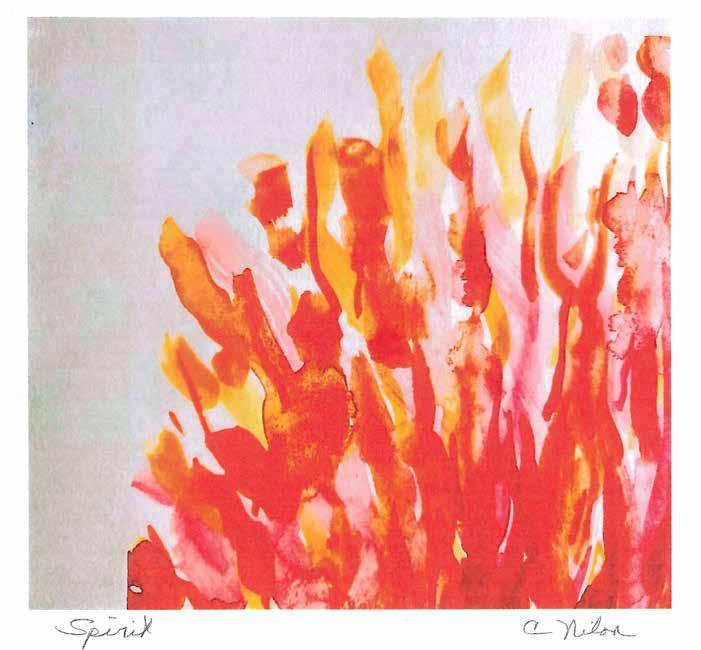
4 minute read
Art, Cathy Nilon
Cathy Nilon, Chaplain M Div. BCC Spiritual Care, Daughter of Joan Nilon
Going my Way
Advertisement
Rita Schneider
2
Our Lady of Sorrows School was five blocks from our house and I attended, as did my brothers and sister, from kindergarten through eighth grade. I don’t remember learning to read or count and I’ve forgotten the names of most of my teachers, but I remember in minute detail the route I walked to school. In spite of the fact that we all attended the same school, I usually walked alone. I went out the back gate into the alley, turning left towards Sigel Avenue. My first stop was Mrs. Reichmeuth’s fence where I popped a few mint leaves into my mouth for the trip. Along the way, I checked out all the ash pits. In St. Louis before World War II, most of the houses were heated with coal furnaces and each house had an ash pit next to the alley. Ash pits were concrete, above ground structures about six feet square and three or four feet high. Besides ashes, anything too big to fit in the garbage can went in the ash pit. Things like three legged chairs, cracked flower pots and bent bicycle wheels. However enticing these items were, Mom did not want me to bring them home. But I couldn’t help looking. One favorite game was our family’s version of baseball. It was played in the yard because we didn’t know that our yard was too small for baseball. The playing field was slightly angled so that home base had a windowless brick wall for a backstop. Then even a wild pitch was not followed by the sound of broken glass. The angle helped prevent, as nearly as possible, hitting the ball into Dittmeier’s yard next door. Hitting the ball into the Dittmeier produced a delay of game since Mrs. Dittmeier did not want us to go into her yard. It also required a bit of planning to recover the ball. Not only was it necessary that Mrs. Dittmeier not see us, but we had to avoid stirring up Mr. Dittmeier’s pigeons and ducks which were kept in their garage and yard. They didn’t know that their yard was too small for raising birds. Our baseball game was a game of skill rather than strength. Any ball hit out of the yard was an out. The games had to be scheduled while Dad was at work because the garage had to be vacant. This was vital because the garage projected into left field and contained a window. During the games, the window had to be propped open for obvious reasons. A ball hit into the open window was an automatic home run. The games were not restricted to family members, but it took a while for others to get used to the rules.
Like most families in South St. Louis during the 1930’s, we listened to the radio whenever we could. The radio programs for kids were in the time slot after school. Jack Armstrong and Little Orphan Annie were favorites. We ate Wheaties cereal and drank Ovaltine to collect the box tops and labels for our decoder rings and Ovaltine mugs. We walked home for lunch every day and listened to some of Mom’s favorite daytime programs while we ate our lunch. Our Gal Sunday, a continuing saga of a country girl who married a wealthy and titled Englishman, came on at noon and we didn’t start back to school until we heard the daily episode. Not only did Mom listen to the daytime programs, she entered some of the contests. Once for finishing the last line of a jingle, we had our laundry done for one week. Mom had a vacation from the washing machine and the ironing board. A truck picked up our dirty clothes and the dresses came back ironed and starched and hanging on hangers. The shirts were folded in wrapped packages with cardboard inside. We thought that was neat! Early in the twentieth century, it was said that St. Louis, Missouri was famous for shoes and booze and last place in the American League. There were, and still are, lots of shoe factories. Because of the large number of Germans populating the city, there were many breweries. While most of the small breweries have disappeared, giant Anheuser-Busch is still very much a presence. My Dad, Walter Albert Thum, was born in St. Louis, one of four children of Frank and Emma Thum. His first job was in a shoe factory operating a machine that was powered by foot pedals. I remember him telling us how he woke in the middle of the night, after starting the job, pedaling in the air. Always good at drawing, he was able to leave the factory later to apprentice as a draftsman and later as a mechanical engineer. Dad told us about meeting a friend from school during this training period. The friend told him about a job opportunity that he thought might interest Dad. A fellow Missouri native named Walt Disney was hiring cartoonists for a new business he was starting. Dad said that he probably would have been hired, but he didn’t apply because he didn’t think there was much of a future in a business like that.
Before the Great Depression, Dad had a small business designing machinery out of his office in downtown St. Louis. During this time, remembering his shoe factory days, Dad invented a machine that eliminated one step in the shoe making process. The Depression forced Dad to move out of his office, so with Pete, his draftsman, set up their drafting tables in our basement and tried to eke out a living. The model of his shoe machine sat in the corner of our basement like a shrine.








